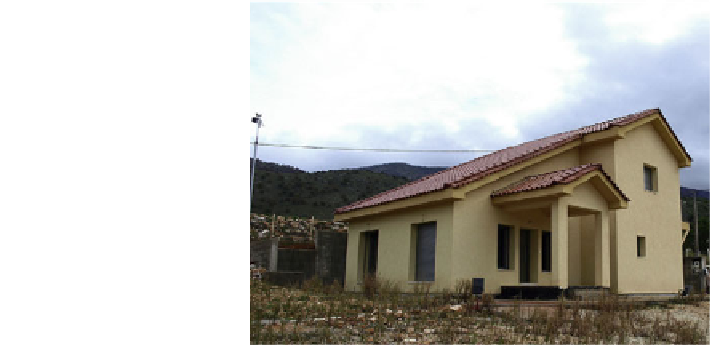Civil Engineering Reference
In-Depth Information
13.6-23.5 C, respectively), a renovated office building in Lyon was monitored
during one year by Kuznik et al. (
2011
). A room was equipped with PCM wall-
boards in the lateral walls and in the ceiling, and another room, identical to the first
one, was not equipped but also monitored. The results showed that the PCM
wallboards enhance the thermal comfort of occupants due to air temperature and
radiative effects of the walls.
Mandilaras et al. (
2013
) present one of the first attempts to investigate the
thermal performance of a purposely built full-scale lightweight demo house con-
structed in Greece which includes PCM gypsum boards in all external walls as
well as in internal partitions of the building (Figs.
4
and
5
). Experimental results
show that the indoor air temperatures in all thermal zones examined (LVR,
MBDR, BDR) do not significantly vary during a 24-h day/night cycle and this can
be attributed to the house's enhanced thermal mass associated with the insulation,
as well as with the absence of a typical occupant behaviour.
The use of PCM in building envelopes has been demonstrated in a long-term
experimental study at the University of Lleida (Spain). Here, different forms of
PCM have been tested in a pilot plant (Fig.
6
) in several identically shaped cubicles
with internal dimensions of 2.4 m 9 2.4 m 9 2.4 m. The cubicles were built using
different typical constructive solutions so concrete cubicles (Cabeza et al.
2007
),
brick cubicles and alveolar brick cubicles (Castell et al.
2010
) can be found.
Two different experiments were performed in the experimental set-up:
• Free-floating temperature, where no cooling system is used. The temperature
conditions inside the cubicles are compared. The ones with PCM are expected to
have a better behaviour.
• Controlled temperature, where a heat pump or an electric oil radiator is used to
set a constant ambient temperature inside the cubicle. The energy consumption
of the cubicles is compared. The cubicles using PCM are expected to have lower
energy consumptions.
Fig. 4 External view of a
demo house including PCM
wallboards (Mandilaras et al.
2013
)

